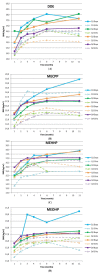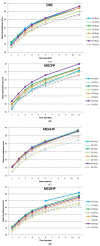First year growth in relation to prenatal exposure to endocrine disruptors - a Dutch prospective cohort study
- PMID: 25014249
- PMCID: PMC4113857
- DOI: 10.3390/ijerph110707001
First year growth in relation to prenatal exposure to endocrine disruptors - a Dutch prospective cohort study
Abstract
Growth in the first year of life may already be predictive of obesity later in childhood. The objective was to assess the association between prenatal exposure to various endocrine disrupting chemicals (EDCs) and child growth during the first year. Dichloro-diphenyldichloroethylene (DDE), mono(2-ethyl-5-carboxypentyl)phthalate (MECPP), mono(2-ethyl-5-hydroxyhexyl)phthalate (MEHHP), mono(2-ethyl-5-oxohexyl)phthalate (MEOHP), polychlorinated biphenyl-153, perfluorooctanesulfonic acid, and perfluoro-octanoic acid were measured in cord plasma or breast milk. Data on weight, length, and head circumference (HC) until 11 months after birth was obtained from 89 mother-child pairs. Mixed models were composed for each health outcome and exposure in quartiles. For MEOHP, boys in quartile 1 had a higher BMI than higher exposed boys (p = 0.029). High DDE exposure was associated with low BMI over time in boys (0.8 kg/m2 difference at 11 m). Boys with high MECPP exposure had a greater HC (1.0 cm difference at 11 m) than other boys (p = 0.047), as did girls in the second quartile of MEHHP (p = 0.018) and DDE (p < 0.001) exposure. In conclusion, exposure to phthalates and DDE was associated with BMI as well as with HC during the first year after birth. These results should be interpreted with caution though, due to the limited sample size.
Figures
References
-
- Bergvall N., Iliadou A., Johansson S., de Faire U., Kramer M.S., Pawitan Y., Pedersen N.L., Lichtenstein P., Cnattingius S. Genetic and shared environmental factors do not confound the association between birth weight and hypertension: A study among swedish twins. Circulation. 2007;115:2931–2938. - PubMed
Publication types
MeSH terms
Substances
LinkOut - more resources
Full Text Sources
Other Literature Sources
Molecular Biology Databases



